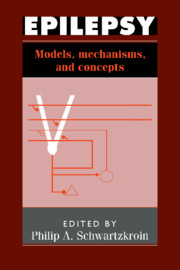Book contents
- Frontmatter
- Contents
- List of contributors
- General introduction
- Section 1 Chronic models in intact animals – concepts and questions
- Section 2 Features of the epileptogenic brain
- Section 3 ‘Normal’ brain mechanisms that support epileptiform activities
- Introduction
- 11 Brain slice models for the study of seizures and interictal spikes
- 12 Generation of epileptiform discharge by local circuits of neocortex
- 13 Study of GABAergic inhibition and GABAA receptors in experimental epilepsy
- 14 High potassium-induced synchronous bursts and electrographic seizures
- 15 Anti-epileptic effects of organic calcium channel blockers in animal experiments
- Recent advances
- Index
13 - Study of GABAergic inhibition and GABAA receptors in experimental epilepsy
from Section 3 - ‘Normal’ brain mechanisms that support epileptiform activities
Published online by Cambridge University Press: 03 May 2010
- Frontmatter
- Contents
- List of contributors
- General introduction
- Section 1 Chronic models in intact animals – concepts and questions
- Section 2 Features of the epileptogenic brain
- Section 3 ‘Normal’ brain mechanisms that support epileptiform activities
- Introduction
- 11 Brain slice models for the study of seizures and interictal spikes
- 12 Generation of epileptiform discharge by local circuits of neocortex
- 13 Study of GABAergic inhibition and GABAA receptors in experimental epilepsy
- 14 High potassium-induced synchronous bursts and electrographic seizures
- 15 Anti-epileptic effects of organic calcium channel blockers in animal experiments
- Recent advances
- Index
Summary
Introduction
Interictal spikes, identifiable as sharp transient deflections (30–50 ms) in electroencephalographic recordings, are electrographic markers of epilepsy (Pedley, 1984). Recordings during epileptic surgery operations show that up to 50% of cells exhibit burst discharge in the focus during interictal spikes (Wyler & Ward, 1981). These studies demonstrate directly that synchronized burst firing in populations of cortical neurons sustains the epileptiform activity. Clearly, information concerning the mechanisms underlying synchronized burst discharge are of fundamental importance to the understanding of epileptogenesis.
That GABAergic (GABA is γ-aminobutyric acid) inhibitory transmission regulates epileptiform activity is indicated by the action of several convulsant compounds. Analogues of interictal spikes can be produced experimentally with agents such as penicillin, bicuculline, and picrotoxin. These agents are all potent blockers of GABAA receptor function (see e.g., Macdonald, 1984). We have asked how a block of GABAA receptors can give rise to synchronized population discharges in cortical neurons.
This chapter describes the application of two in-vitro preparations from guinea pig in studies to assess the role of GABAergic inhibition in the control of epileptiform discharges. In hippocampal slices we have used dual recordings to examine, at the unitary level, synapses involved in the generation of recurrent inhibition and excitation. Acutely dissociated hippocampal neurons have allowed a detailed examination of intracellular regulation of the efficacy of GABAA receptors. The account is based primarily on our own experiments using the hippocampal slice and dissociated cell preparations.
- Type
- Chapter
- Information
- EpilepsyModels, Mechanisms and Concepts, pp. 424 - 436Publisher: Cambridge University PressPrint publication year: 1993
- 27
- Cited by

